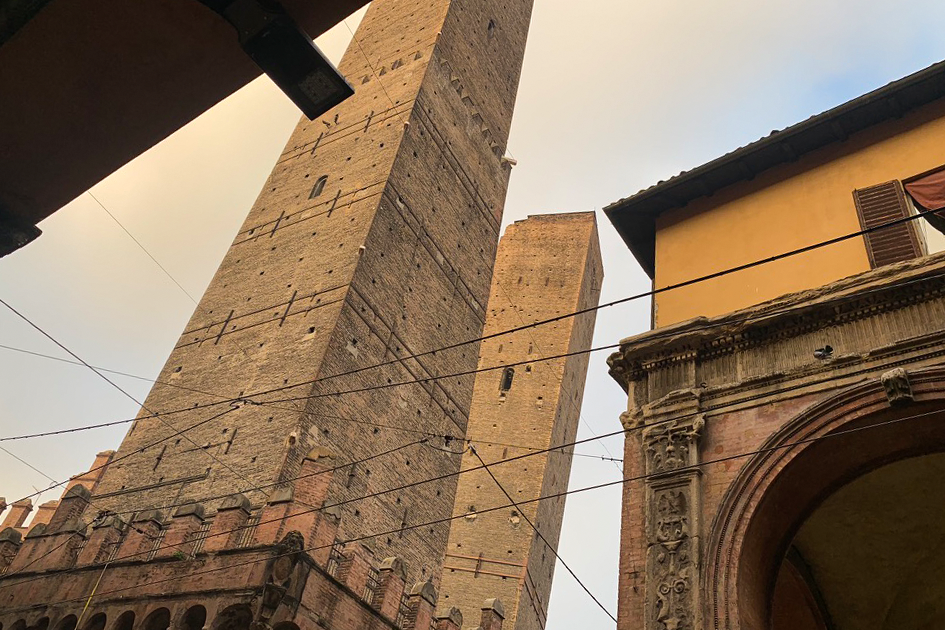Bologna’s 12th century Garisenda Tower has recently surpassed the famous tilt of Pisa’s Leaning Tower. Tourists flock to the city, even though the area around the tower is closed, as the four-degree tilt puts the city in the global spotlight. Despite safety concerns, a €20 to €30 million restoration project is underway.
“The Tower is not just a landmark, it’s a part of us and we will do whatever it takes to see it stand straight again,” says Francesco.
The cigar-smoking man with the brown hat has been selling iconic prints of famous people, Italian monuments, and old adverts for decades under an arch at Bolognas Plaza Maggiore. Francesco has seen generations passing by, but the two towers have always been a constant in his life.
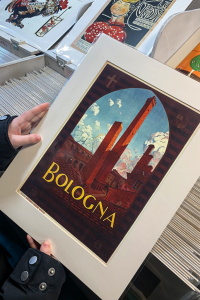
One of the prints Francesco sells in the city center.
Walking past the yellow, pink, and orange houses along the main road leading to the two famous towers – Garisenda and Asinelli – the inclination of the 48m high Garisenda is alarmingly obvious. At night, the towers are lit up in bright colours, and in the winter months the fog adds a mystical atmosphere to the landscape. Garisenda tower highlights the challenges of preserving cultural landmarks and the city of Bologna’s determination to protect its heritage. As discussions with city officials progressed, it became clear that this leaning monument is more than just a structural marvel. It is a symbol of community, resilience and the delicate dance between history and progress.
Challenge and Commitment
Born and raised in Bologna, the Deputy Mayor, Simone Borsari, has a personal connection with the Garisenda Tower. The meeting with the man responsible for overseeing public works, maintenance and the removal of architectural barriers takes place next to the construction site beneath the two towers. Sipping an espresso in a café nearby, Borsari stressed the city’s commitment to preserving the tower.
“The tower plays an important role for attracting people and operations. That’s why it’s important to preserve it and give the best”.
He also admitted that the next “long period” would be difficult for the people who live and work near Garisenda, but that the city would take measures to make them as comfortable as possible. For example, the work zone, which has effectively closed off what was once a wide-open space in front of the towers, will be lit up at night to reduce shadows and dark areas so that people can feel safer walking through the area at night. Cultural events will be held near the work zone to make it more attractive and attract customers to the shops and restaurants in the city centre. So far, there are no concrete plans to make the tower more accessible.
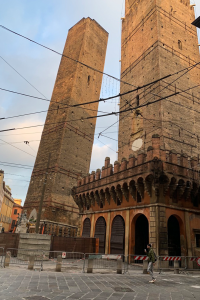
The tilt of Garisenda is very obvious looking at it from Strada Maggiore.
Valentina Orioli, former Deputy Mayor and now Councillor for New Mobility, Infrastructure, Public Transport and Cultural Heritage, points out the importance of the Tower as a symbol of mobility, with all the main public transport lines passing underneath it in the heart of the city centre.
“The decision to close this area and make it pedestrian for the period of the works is a very hard one because it involves changing the way the city moves.”
Orioli is responsible for managing the challenges posed by the restoration, particularly in terms of public transport and the functioning of local businesses.
“Leaning towers are a normal thing”
The tower has been monitored by a committee for several years. It has always been leaning, but in autumn there was an unexpected movement. Orioli, an architect herself, is not worried about the tower’s possible collapse. “A lot of towers are leaning back, so it’s quite normal and I don’t think it will collapse ever in the future. Maybe there is an increase in risk, but we are not thinking about towers collapsing, we are just taking the right measures to avoid even the risk of that happening”. Orioli also reassured those ancient structures, including towers, are more resilient than they appear:
“An ancient structure that has always remained in a certain state is in a sense adapted to resist. This is very evident when we have earthquakes, for example. In Italy they are quite frequent, but there are a lot of ancient monuments that don’t have damage because they have adapted in their own massive structure to resist a certain kind of stress”.
Uncertain action plan, certain support
Simone Borsari outlined the council’s two-step action plan: first, to ensure the safety of citizens and monuments by sealing off the area, and second, to get involved in the restoration process. The first phase has already begun; the restoration is still under discussion with various experts. The deputy mayor stressed the uniqueness of the case, citing the difficulties posed by the materials of the towers, the soil, their historical use and their location right in the city centre, surrounded by other buildings.
“This is going to change life in our city as a totality. Because this is the real centre of our city. There are so many things that need to be taken into account, like business mobility, infrastructure, urban services for people. These things must be considered, and a few months are not enough to make a decision”.
Borsari highlighted the importance of community support, citing the city’s crowdfunding campaign, in which many individuals and companies donated money with the Art Bonus. By the end of 2023, more than €3.3 million had been raised.
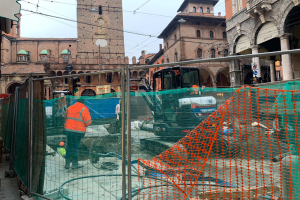
Garisenda is closed off for pubic. Constructions in the surrounding area are taking place.
“There is a sense of recognition as a community behind this and we are sure that in the end the community will be stronger and the citizens will see the Garisenda and they will see themselves in this tower and as part of Bologna,” says Borsari.
Linda, a well-dressed woman wearing dark sunglasses, is on her way home after work. She stops under the tower to take a picture of the leaning Garisenda for her husband. “I have lived in Bologna all my life and the Garisenda Tower has always been part of my daily life. When I heard about the (crowdfunding) campaign, it was natural for me to contribute. It isn’t just bricks, it’s a part of our identity”. She was one of the many private citizens who donated anything from €1 to €500 towards the restoration with the support of Art Bonus.
Addressing citizens’ concerns
Valentina Orioli also acknowledged the significance of the tower for the people of Bologna. She wants to keep citizens informed about the restoration process. Despite the inconvenience caused by closures and disruptions, she highlighted ongoing efforts to support affected businesses and develop sustainable solutions for the city’s future. For example, the shop owners have already met with the Councillor for Commerce to discuss financial support over the coming years.
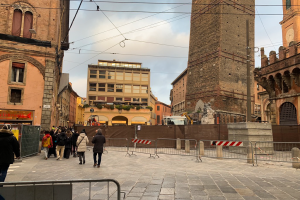
People stop by to take a look at the leaning Garisenda.
She also spoke of the consensus among people, regardless of political affiliation, on the importance of preserving such historical monuments.
“There can be a discussion about the timing of the intervention and so on, but in the end, everyone agrees with the idea of taking care of these kinds of buildings.”
The tilt of Bologna’s Garisenda Tower may be a testament to the city’s resilience. Its restoration isn’t just a challenge, it’s an opportunity for the city to redefine its commitment to history, community and progress. While experts debate the process, Bologna stands united, understanding that the preservation of its historic monuments is a strength of its identity. And Garisenda is on its way to becoming a new symbol, one of resistance and reconstruction.
Facts and Figures
- Garisenda Tower was built between 1109 and 1119. The tower is 48 meters tall and stands next to its famous companion the 97-meter high Asinelli tower. They are known as Bologna’s Two Towers.
- Garisenda has leaned since it was built and “has been a concern ever since”, says Bologna’s mayor Matteo Lepore. The tower currently slants at 4 degrees, surpassing Italy’s more famous Leaning Tower of Pisa with its 3.9 degrees.
- The towers were built by two rival families competing over their power and wealth. The Garisenda was originally 60 meters tall but already had to be lowered after it began to lean very shortly after it was built.
- The tower has been providing inspiration over centuries to painters and poets (e. g. it is mentioned several times in Dante Alighieris “Divine Comedy” and cited in Charles Dickens “Pictures from Italy” as well as Goethes “Italian Journey”) and has served as a lookout spot during conflicts.
- People can donate money for Garisendas restoration with the Art Bonus. That is a in 2014 introduced tax credit for charitable donations in support of culture and entertainment to preserve cultural heritage.
